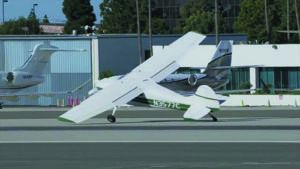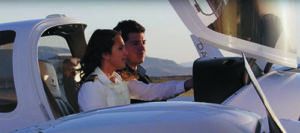Correspondence from the FAA is enough to elevate a pilot’s heart rate we’ll into triple digits. A letter from the FAA stating that the pilot’s competence has been called into question and requesting that the pilot take a reexamination checkride with an FAA inspector will make even the toughest pilot go weak in the knees.
Pilot reexamination—what does it mean? Can the FAA do that to me? What triggered the FAA’s sudden interest in me? How do I deal with it? Can I make it go away? Who do they think they are?
We’ll answer all of those questions, and toss in some recommendations for actions you should take if you ever get an FAA letter asking you to appear for a checkride to reexamine your competence as an aviator. We’ll also talk about some questions that you should ask yourself if you ever get such a letter.
THE LEGALITIES
When Congress established the FAA, it gave it wide powers to take action needed to carry out its mission to make aviation as safe as possible for the general public. That included permitting the FAA “to reexamine an airman holding a pilot certificate.” When can the FAA do this, you ask? According to the law, 49 U.S.C. 44709(a), the answer is “any time.”
That’s scary. Congress gave the FAA free rein to reexamine pilots. Fortunately, when the FAA set up its own operational standards by which it would enforce the law—FAA Order 8900.1 Flight Standards Information Management System—it did not give its inspectors the authority to reexamine pilots any time they felt so inclined. Instead, the FAA required that there must be some reasonable basis for the FAA to question the pilot’s competence before it can require a reexamination checkride—suspicion is not enough.
THE TRIGGER
Order 8900.1 gives a succinct description as to what most commonly triggers a request that a pilot take a 709 ride: “In most cases a reexamination will result from the inspector’s investigation of an accident or incident where the airman’s competence was the apparent cause
of the occurrence.” In talking with FAA inspectors we were told that the most common pilot competence events that triggered 709 rides were running out of fuel, a groundloop (with damage) or inadvertently landing gear up.
THE LETTER
The FAA starts the 709 procedure by sending you a letter by certified mail describing the situation and inviting you demonstrate to the FAA that you still have the qualifications and skills for your certificates and ratings within 15 days. The letter will explain the details of the reexamination, including what areas are to be tested and the type of aircraft to be used.
While it is an invitation, attendance is mandatory. If you ignore the letter the FAA will begin an emergency enforcement action to suspend your certificate.
We have looked at some of the cases where a pilot tried to fight the certificate action by alleging that the FAA didn’t have the right to reexamine the pilot (never successful) or that it didn’t have sufficient cause for the reexamination (we found none that were successful).
At the same time, we’re aware of times that the FAA was considering a 709 ride for a pilot, but the pilot had stayed in touch with the FAA inspector who investigated the accident and was able to show that—in one case—the airplane ran off of the runway due to a mechanical failure in the nosegear steering mechanism. The FAA closed its file without taking any action.
NOW WHAT?
The chances are that you’re still suffering embarrassment that you’ve scratched an airplane and now you feel like the FAA wants to kick you while you’re down. Nevertheless, we suggest that you spend about 15 seconds feeling good and sorry for yourself and then start taking action. First, contact an aviation lawyer. We recommend that pilots subscribe to AOPA’s (www.aopa.org) Pilot Protection Services—it’s designed for situations like this. Even if you’re not a subscriber, you can call them and get names of aviation attorneys in your area. Talk with an attorney about your situation and get advice before going further.
In general, the next step will be for you to call the FAA inspector who sent the letter and discuss getting the checkride scheduled as we’ll as talking a little about the incident. The FAA has some leeway on the 15-day requirement, especially if you were injured or there is some difficulty for you to get access to a similar airplane. No matter what, the idea is to make contact and start things moving toward taking the 709 ride so that you don’t run out the clock and face an enforcement action.
Then, and we can’t emphasize this enough—go to a trusted CFI and take dual on the areas that will be examined on your ride. Insist that the instructor be completely honest with you as to whether she or he thinks that you can meet the Airman Certification Standards (ACS) for your certificates and that you can pass the ride.
If the instructor says that you can’t, get a second opinion. If that instructor says you can’t, it may be time for a long talk with yourself as to whether you should continue flying. FAA inspectors and CFIs tell us that in about 10 percent of the 709 ride matters the pilot involved has kept flying too long and, because of the realities of aging, can no longer meet ACS standards.
If you decide that you probably won’t pass the 709 ride, it may be time to surrender your certificate. Talk with your attorney before doing so as there may be some options such as just giving up your instrument rating and continuing to fly VFR.
THE RIDE

A 709 ride is a checkride that covers only limited areas, but it is to the ACS for the certificates you hold. Pilots who have reported to us after a 709 ride have all remarked that the inspector was fully aware that the pilot was extremely nervous and embarrassed to be there and worked to create a non-threatening atmosphere.
While you may be there to demonstrate landings and they will probably be the primary focus of the conversation you have prior to flight, you’ll be expected to know the systems, V speeds and emergency procedures for the airplane you’re flying.
The flight will probably be fairly short—assuming you demonstrate mastery of the aircraft. If the focus is landings, the flight should not include steep turns under the hood; it must be focused on the reason you were called in to demonstrate your abilities.

If you pass—and from what our research shows, 90 to 95 percent of pilots do—that’s it. The inspector takes care of paperwork and you go on to what we hope are many more years of enjoyable flying.
FAILING THE RIDE
If you fail you have some options. You can surrender your certificate. There are formalities associated with that, including that you have to do it in writing. Alternatively, you can request another checkride. Inspectors told us that they almost always agree and also set it up with another inspector to avoid any claim that the inspector was biased.
Our discussions with inspectors revealed that they don’t like failing pilots on 709 rides and that a failure is rarely a “near thing.” When pilots fail a 709, they apparently do it in a big way, being unable to come close to objective standards such as airspeed, altitude and heading tolerances.
We also learned that only a tiny minority of pilots who fail a 709 ride pass it on the second try.
If, after failure, the pilot refuses to surrender her or his pilot certificate, the FAA starts an emergency revocation action. We could not find one pilot who was able to win one and we saw some pretty intense (and sometimes irrational) efforts by pilots to show that the FAA was out to get them. Some of those showed indications that the pilots involved may also not have had both oars in the water.
In our opinion, if you fail a 709 ride, it’s time to have a long talk with your family, a trusted CFI and aviation lawyer, consider the good long run you’ve had in aviation and give serious thought to surrendering your certificate with dignity rather than having it taken away.


